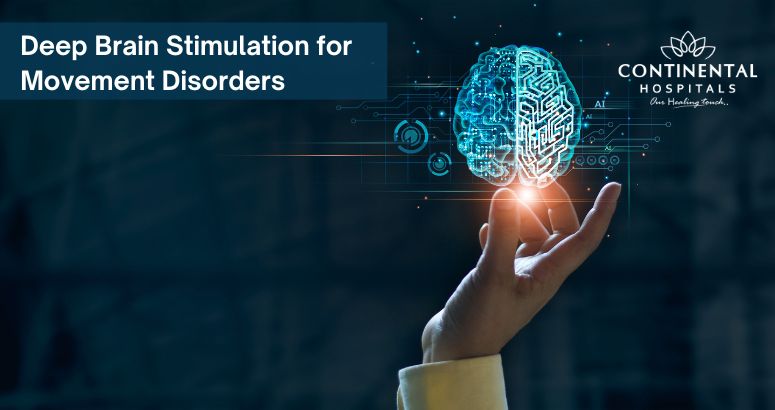- Email: [email protected]
- International Concierge : +91 995 166 0000
- General Enquiry : +91 40 6700 0000
Deep Brain Stimulation for Movement Disorders

Movement disorders are a group of neurological conditions that affect a person's ability to control their movements. These can be tremors, stiffness, slowness, or involuntary muscle contractions. While medications can often help manage symptoms, there comes a point for some patients where medication loses effectiveness or side effects become too burdensome.
Deep brain stimulation (DBS) offers a lot of hope in such situations. This innovative surgical procedure uses implanted electrodes to deliver electrical stimulation to specific areas of the brain, effectively modulating abnormal activity and improving movement control.
Understanding Movement Disorders
Movement disorders encompass a range of conditions that affect the nervous system's ability to coordinate and control movement. Some of the most common ones include:
Parkinson's disease (PD): A neurodegenerative disorder characterized by tremors, rigidity, slowness of movement (bradykinesia), and postural instability.
Essential tremor: A neurological condition causing involuntary shaking, primarily affecting the hands and head.
Dystonia: A movement disorder causing involuntary muscle contractions, often leading to twisting postures or repetitive movements.
These conditions can significantly impact daily activities, affecting everything from eating and dressing to writing and walking.
When Medication Isn't Enough: The Role of DBS
Medications are the mainstay of treatment for many movement disorders. However, their effectiveness can decline over time, or patients may experience debilitating side effects. DBS emerges as a powerful tool in such scenarios.
Here's how DBS works:
Implantation: A minimally invasive surgical procedure involves placing thin electrodes in specific areas of the brain responsible for movement control.
Stimulation: The electrodes are connected to an implantable pulse generator (IPG), similar to a pacemaker, placed under the collarbone.
Electrical signals: The IPG delivers mild electrical pulses to the targeted brain regions, interrupting abnormal neural activity and improving movement control.
Benefits of DBS:
Significant improvement in symptoms: DBS can dramatically reduce tremors, stiffness, and involuntary movements, enhancing a patient's quality of life.
Medication reduction: DBS may allow for a reduction in medication dosage, minimizing side effects.
Adjustable therapy: Unlike ablative procedures that destroy brain tissue, DBS is adjustable. The stimulation settings can be fine-tuned over time to optimize results.
Reversibility: If needed, the DBS system can be deactivated or even removed.
Who is a Candidate for DBS?
DBS is not a one-size-fits-all solution. It's a complex procedure with specific criteria for candidacy. Here are some general considerations:
Severity of symptoms: Patients with severe movement disorders that significantly impair daily life and are inadequately controlled with medications are potential candidates.
Age and health: Generally, DBS is offered to patients between 18 and 70 years old in good overall health.
Accurate diagnosis: A clear diagnosis of the underlying movement disorder is crucial for successful DBS targeting.
DBS Journey: What to Expect
The DBS process involves several stages:
Comprehensive evaluation: A team of specialists, including neurologists, neurosurgeons, and psychiatrists, will assess your medical history, symptoms, and suitability for DBS.
Imaging tests: Brain scans like MRI are used to pinpoint the precise location for electrode placement.
Surgical procedure: The DBS surgery is performed under general anesthesia.
Programming and adjustments: Following implantation, the DBS system is programmed to deliver optimal stimulation. This may involve fine-tuning over a few days or weeks.
Follow-up care: Regular follow-up appointments are essential to monitor progress, adjust settings, and address any potential complications.
Benefits of DBS:
Symptom Management: DBS can effectively manage symptoms associated with movement disorders such as Parkinson's disease, essential tremor, and dystonia. It can significantly reduce tremors, rigidity, and bradykinesia (slowness of movement), thereby improving overall motor function and quality of life.
Medication Reduction: For some patients, DBS can allow for a reduction in the dosage of medication needed to manage their condition. This reduction in medication can help minimize side effects and improve overall well-being.
Long-term Relief: DBS can provide long-term relief from symptoms, especially when medications become less effective over time or when they cause undesirable side effects. It offers consistent symptom control and stability, even as the disease progresses.
Improved Functionality: By alleviating motor symptoms, DBS can enhance a person's ability to perform daily activities, maintain independence, and engage in social interactions. This improvement in functionality can lead to greater autonomy and a higher quality of life.
Adjustable and Reversible: DBS is adjustable, allowing healthcare providers to fine-tune stimulation settings to optimize symptom control and minimize side effects. Additionally, it is reversible, meaning that the stimulation can be turned off or adjusted if necessary, providing flexibility in treatment.
Non-destructive: Unlike some surgical interventions for neurological conditions, DBS does not permanently destroy brain tissue. Instead, it modulates neural activity through controlled electrical stimulation, preserving the option for future treatments or advancements in medical technology.
Applicability to Multiple Conditions: While initially developed for Parkinson's disease, DBS has shown efficacy in treating other neurological conditions such as essential tremor, dystonia, and obsessive-compulsive disorder (OCD), expanding its potential benefits to a broader range of patients.
Deep brain stimulation represents a remarkable breakthrough in the treatment of movement disorders, offering hope and improved quality of life for thousands of patients worldwide. While it is not a cure, DBS can significantly alleviate symptoms and enable patients to lead more fulfilling lives. With continued research and innovation, the future of DBS holds even greater promise for those living with movement disorders.
.webp)
